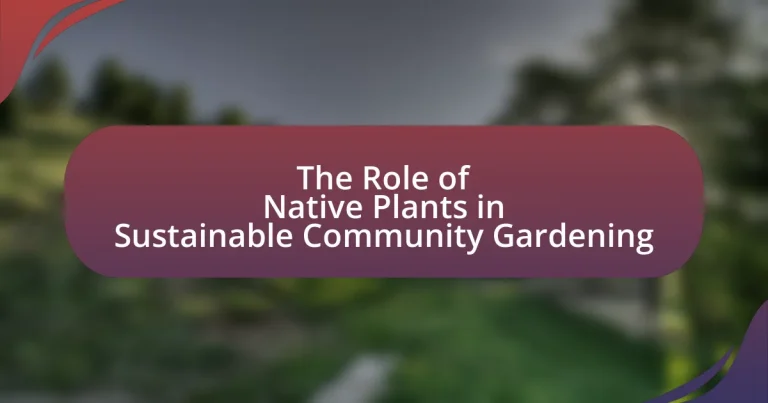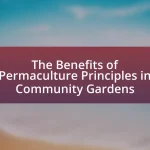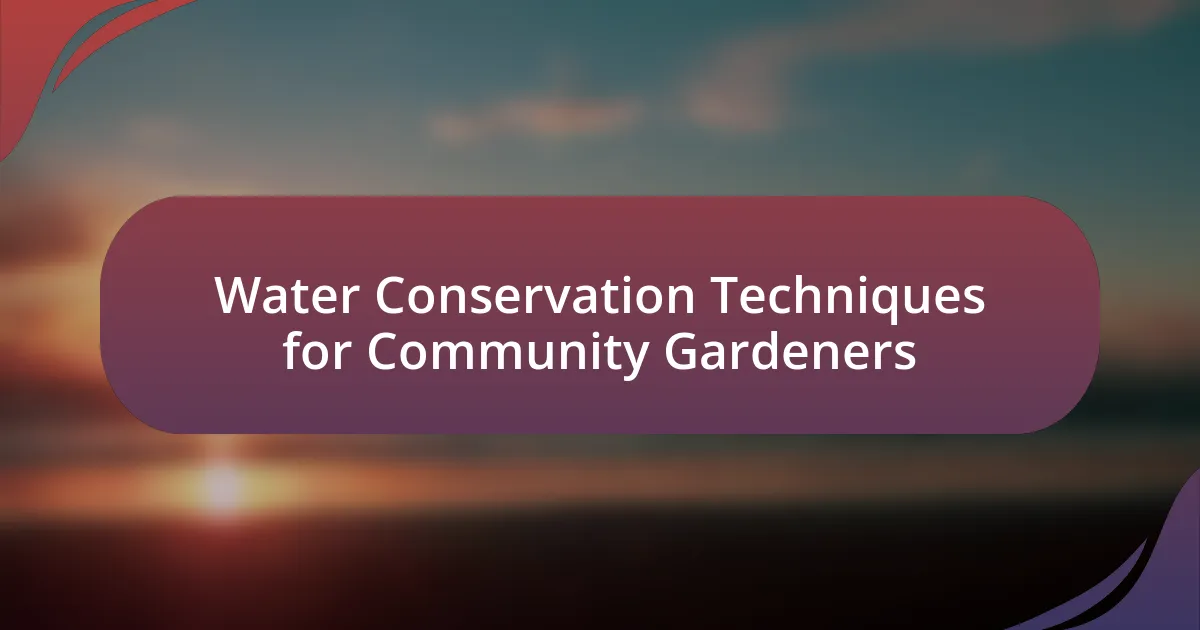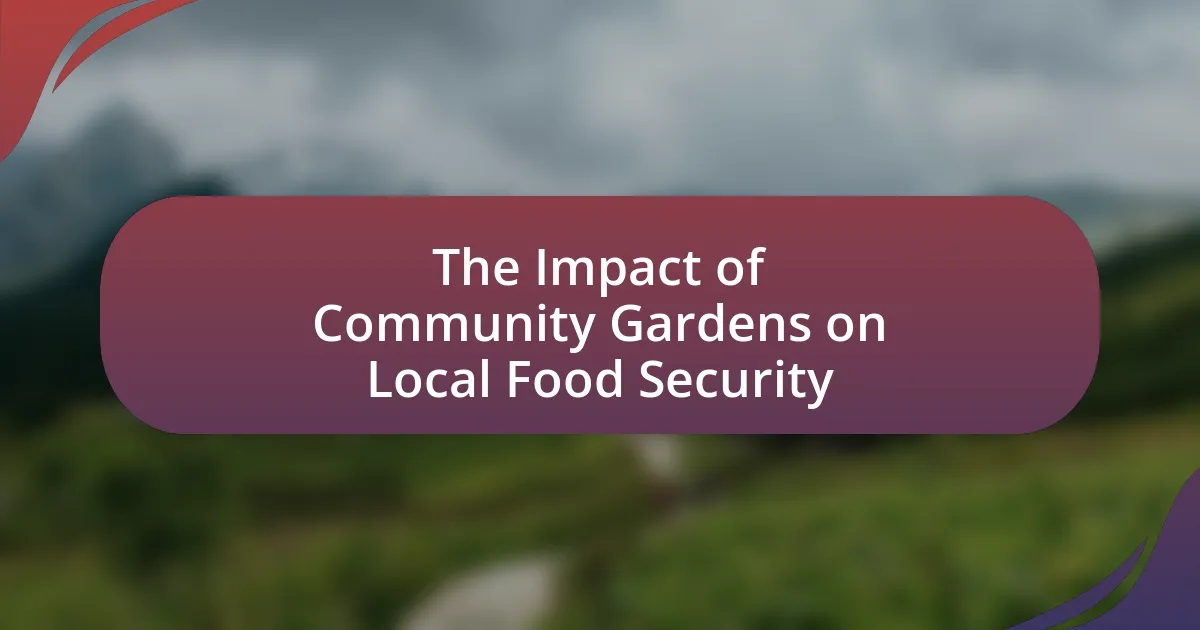Native plants are species that naturally occur in specific regions and play a crucial role in sustainable community gardening by supporting local ecosystems and enhancing biodiversity. This article explores the importance of native plants, highlighting their advantages over non-native species, such as lower maintenance requirements and better adaptation to local soil and climate conditions. It discusses how native plants contribute to biodiversity, provide essential habitats for wildlife, and promote sustainable gardening practices. Additionally, the article outlines best practices for integrating native plants into community gardens, the social and educational benefits of these initiatives, and strategies for community engagement and long-term maintenance.
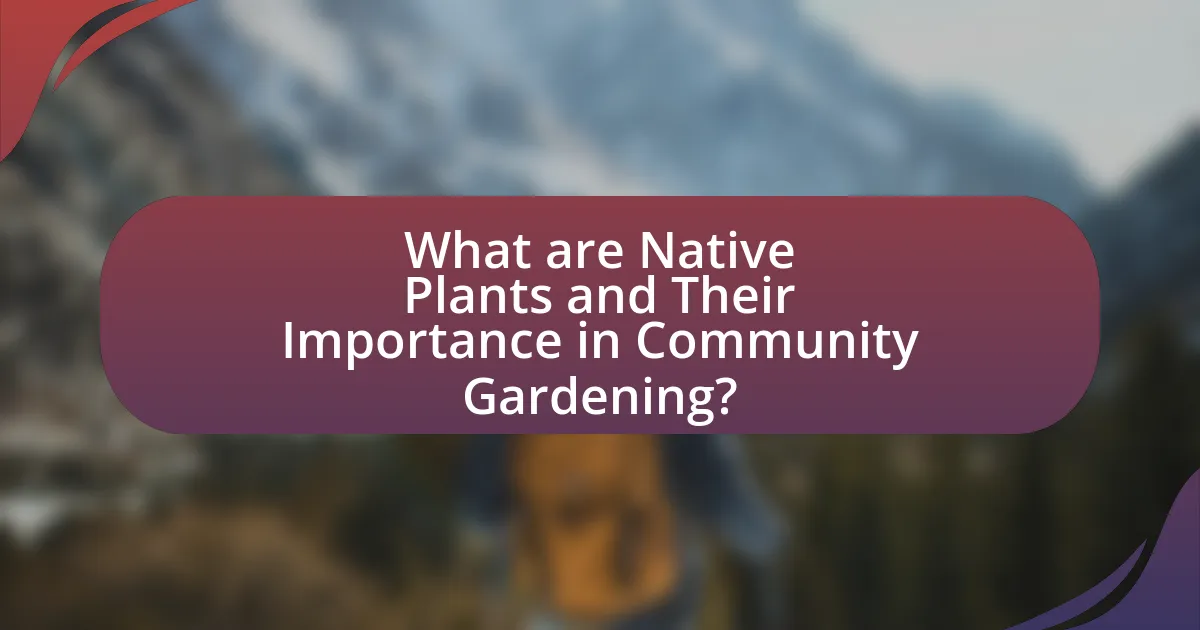
What are Native Plants and Their Importance in Community Gardening?
Native plants are species that naturally occur in a specific region without human introduction. Their importance in community gardening lies in their ability to support local ecosystems, enhance biodiversity, and require less maintenance compared to non-native species. Research indicates that native plants provide essential habitats for pollinators and other wildlife, contributing to healthier ecosystems. For example, a study published in the journal “Ecological Applications” found that gardens with native plants had 50% more native bee species than those with non-native plants, highlighting their role in promoting local biodiversity. Additionally, native plants are adapted to local soil and climate conditions, which reduces the need for irrigation and chemical fertilizers, making them a sustainable choice for community gardens.
How do native plants differ from non-native species?
Native plants are species that naturally occur in a specific region, while non-native species are introduced from other areas. Native plants have adapted to local environmental conditions, supporting local wildlife and ecosystems, whereas non-native species may disrupt these ecosystems by outcompeting native flora for resources, potentially leading to biodiversity loss. Studies show that native plants provide essential habitat and food for native pollinators and other wildlife, reinforcing their ecological importance in sustainable community gardening.
What characteristics define native plants?
Native plants are defined by their adaptation to the local environment, meaning they have evolved to thrive in specific climatic and soil conditions of their native regions. These plants typically require less water and maintenance compared to non-native species, as they are well-suited to local rainfall patterns and soil types. Additionally, native plants support local wildlife, providing essential habitat and food sources for native pollinators and other organisms. Research indicates that using native plants in landscaping can enhance biodiversity and ecosystem resilience, as they are integral to maintaining the ecological balance within their habitats.
Why are native plants better suited for local ecosystems?
Native plants are better suited for local ecosystems because they have evolved to thrive in specific environmental conditions, making them more resilient and adaptable. These plants support local wildlife, including pollinators and other beneficial organisms, by providing essential food and habitat. Research indicates that native plants can enhance biodiversity; for instance, a study published in the journal “Ecological Applications” found that gardens with native species supported 50% more pollinator species compared to those with non-native plants. Additionally, native plants require less water and fewer chemical inputs, promoting sustainable gardening practices and reducing environmental impact.
What role do native plants play in sustainable gardening practices?
Native plants are essential in sustainable gardening practices as they promote biodiversity, require less water, and reduce the need for chemical fertilizers and pesticides. By using native plants, gardeners can create ecosystems that support local wildlife, including pollinators like bees and butterflies, which are crucial for plant reproduction. Studies show that native plants are adapted to local soil and climate conditions, making them more resilient and easier to maintain compared to non-native species. This adaptability leads to lower water usage; for instance, native plants typically require 30-50% less water than non-native varieties. Additionally, native plants contribute to soil health by preventing erosion and improving nutrient cycling, further enhancing the sustainability of gardening practices.
How do native plants contribute to biodiversity?
Native plants contribute to biodiversity by providing essential habitats and food sources for a wide range of wildlife, including pollinators, birds, and other organisms. These plants are adapted to local environmental conditions, which allows them to thrive and support diverse ecosystems. For instance, a study published in the journal “Ecological Applications” by Tallamy and Shriver (2018) found that landscapes dominated by native plants support significantly more species of insects and birds compared to those with non-native species. This increase in species richness enhances ecosystem resilience and stability, demonstrating the critical role of native plants in maintaining biodiversity.
What ecological benefits do native plants provide?
Native plants provide significant ecological benefits, including enhanced biodiversity, improved soil health, and increased resilience to climate change. These plants support local wildlife by offering food and habitat, which fosters a diverse ecosystem. For instance, native plants are essential for pollinators; studies show that areas with native flora have higher populations of bees and butterflies, crucial for pollination. Additionally, native plants improve soil health by preventing erosion and promoting nutrient cycling, as their deep root systems stabilize the soil and enhance water retention. Furthermore, they are adapted to local climate conditions, making them more resilient to extreme weather events, which is vital for maintaining ecosystem stability in the face of climate change.
Why should communities prioritize native plants in gardening initiatives?
Communities should prioritize native plants in gardening initiatives because they enhance local biodiversity and support ecosystem health. Native plants are adapted to the local climate and soil conditions, requiring less water and maintenance compared to non-native species. Research indicates that gardens with native plants can attract a greater variety of pollinators, such as bees and butterflies, which are essential for food production and ecological balance. For example, a study published in the journal “Ecological Applications” found that native plant gardens can increase pollinator diversity by up to 50% compared to traditional gardens. By prioritizing native plants, communities can create sustainable environments that foster wildlife, reduce resource consumption, and promote ecological resilience.
What are the social benefits of using native plants in community gardens?
Using native plants in community gardens fosters social cohesion and enhances community engagement. Native plants attract local wildlife, which can create a shared interest among community members in biodiversity and environmental stewardship. This shared interest often leads to increased collaboration and participation in gardening activities, strengthening social ties. Additionally, community gardens featuring native plants can serve as educational platforms, where residents learn about local ecology and sustainable practices, further promoting community interaction and knowledge sharing. Studies have shown that such gardens can improve mental well-being and provide a sense of belonging, as they create spaces for social gatherings and cultural exchange.
How can native plants enhance community engagement and education?
Native plants enhance community engagement and education by fostering a sense of local identity and promoting biodiversity awareness. When communities incorporate native plants into gardens, they create spaces that reflect local ecosystems, which encourages residents to participate in gardening activities and stewardship programs. Research indicates that community gardens featuring native plants can increase participation rates by up to 30%, as they provide opportunities for hands-on learning about local flora and fauna. Additionally, educational workshops focused on native plant cultivation can improve knowledge about environmental sustainability, as evidenced by studies showing that participants in such programs demonstrate a 50% increase in understanding of ecological principles.
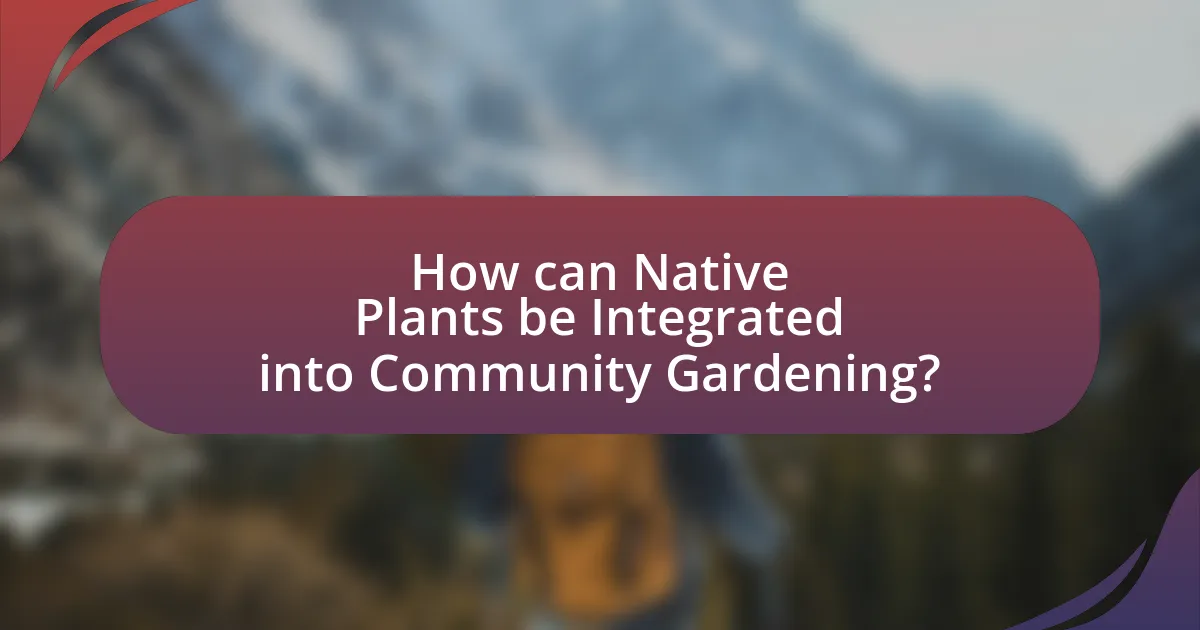
How can Native Plants be Integrated into Community Gardening?
Native plants can be integrated into community gardening by selecting species that are well-adapted to the local environment, which enhances biodiversity and supports local ecosystems. Incorporating native plants helps reduce water usage and maintenance needs, as these plants are typically more resilient to local climate conditions. Research indicates that gardens featuring native plants can attract beneficial pollinators and wildlife, thereby promoting ecological balance. For example, a study published in the journal “Ecological Applications” found that urban gardens with native flora had significantly higher levels of pollinator diversity compared to those with non-native species. This integration not only fosters a sustainable gardening practice but also educates community members about the importance of local flora and fauna.
What steps are involved in selecting native plants for community gardens?
The steps involved in selecting native plants for community gardens include assessing local environmental conditions, researching suitable native species, evaluating plant availability, and considering community preferences. First, assessing local environmental conditions involves analyzing soil type, sunlight, and moisture levels to ensure compatibility with plant needs. Next, researching suitable native species entails identifying plants that thrive in the specific region and contribute to local biodiversity. Evaluating plant availability requires checking local nurseries or native plant sales for sourcing these species. Finally, considering community preferences ensures that the selected plants align with the interests and aesthetic desires of the community members, fostering engagement and support for the garden.
How can local climate and soil conditions influence plant selection?
Local climate and soil conditions significantly influence plant selection by determining which species can thrive in a specific environment. Climate factors such as temperature, precipitation, and sunlight affect plant growth and survival, while soil conditions, including pH, texture, and nutrient availability, dictate the types of plants that can establish roots and access essential resources. For instance, native plants are often better suited to local climates and soils, as they have adapted over time to these specific conditions, leading to higher survival rates and lower maintenance needs. Research indicates that using native plants in community gardening can enhance biodiversity and resilience, as they are more likely to withstand local pests and diseases compared to non-native species.
What resources are available for identifying suitable native plants?
Resources available for identifying suitable native plants include local extension services, native plant societies, and online databases such as the USDA PLANTS Database. Local extension services provide region-specific guidance and expertise on native plants, while native plant societies often offer educational resources and plant lists tailored to specific areas. The USDA PLANTS Database is a comprehensive online resource that includes information on plant species, their native ranges, and ecological characteristics, making it a valuable tool for gardeners seeking to incorporate native plants into their gardens.
How can community members be involved in the planting process?
Community members can be involved in the planting process by participating in organized planting events, where they can help plant native species that support local ecosystems. These events often include educational workshops that teach participants about the benefits of native plants, such as their role in promoting biodiversity and reducing water usage. Research shows that community engagement in gardening activities fosters a sense of ownership and responsibility towards local green spaces, enhancing community cohesion and environmental stewardship.
What roles can volunteers play in establishing native plant gardens?
Volunteers can play several critical roles in establishing native plant gardens, including planning, planting, maintenance, and education. In the planning phase, volunteers can assist in selecting appropriate native plant species that thrive in the local ecosystem, ensuring biodiversity and sustainability. During the planting phase, they can help with the physical installation of plants, which is essential for the garden’s establishment. Maintenance tasks, such as weeding, watering, and mulching, are also vital roles that volunteers can undertake to ensure the garden’s health and longevity. Additionally, volunteers can engage in educational outreach, teaching community members about the benefits of native plants and sustainable gardening practices, thereby fostering a greater appreciation for local ecosystems. These roles collectively contribute to the successful establishment and ongoing sustainability of native plant gardens.
How can workshops and educational programs facilitate community involvement?
Workshops and educational programs facilitate community involvement by providing hands-on learning experiences that engage participants in sustainable practices. These programs often focus on native plants, teaching community members about their ecological benefits and how to incorporate them into local gardening efforts. Research indicates that community gardening initiatives, which include educational workshops, can increase local biodiversity and foster social connections among residents. For example, a study by the American Community Gardening Association found that community gardens enhance neighborhood cohesion and promote environmental stewardship, demonstrating the effectiveness of educational programs in mobilizing community action.
What maintenance practices are necessary for native plant gardens?
Native plant gardens require specific maintenance practices to thrive, including regular weeding, mulching, and monitoring for pests. Weeding is essential to prevent invasive species from outcompeting native plants, while mulching helps retain soil moisture and suppresses weed growth. Additionally, monitoring for pests ensures that any infestations are addressed promptly, maintaining the health of the garden. Research indicates that native plants are adapted to local conditions, which often reduces the need for extensive maintenance compared to non-native species, making these practices particularly effective in promoting sustainability in community gardening.
How can communities ensure the long-term health of native plants?
Communities can ensure the long-term health of native plants by implementing conservation practices, promoting biodiversity, and engaging in education and stewardship programs. Conservation practices, such as protecting natural habitats and restoring degraded areas, help maintain the ecosystems that support native plants. Promoting biodiversity through planting a variety of native species enhances resilience against pests and diseases. Education and stewardship programs raise awareness about the importance of native plants, encouraging community members to participate in their care and preservation. Studies show that communities with active conservation efforts see a significant increase in native plant populations, which contributes to overall ecosystem health.
What common challenges might arise in maintaining native plant gardens?
Common challenges in maintaining native plant gardens include invasive species, soil quality issues, and water management. Invasive species can outcompete native plants, leading to reduced biodiversity and garden health. Soil quality may not always be optimal for native plants, requiring amendments or specific management practices to ensure proper growth. Additionally, water management can be challenging, as native plants may have varying water needs, making it essential to monitor and adjust irrigation practices accordingly. These challenges are supported by studies indicating that invasive species can significantly impact local ecosystems, while proper soil and water management are critical for the success of native plant gardens.
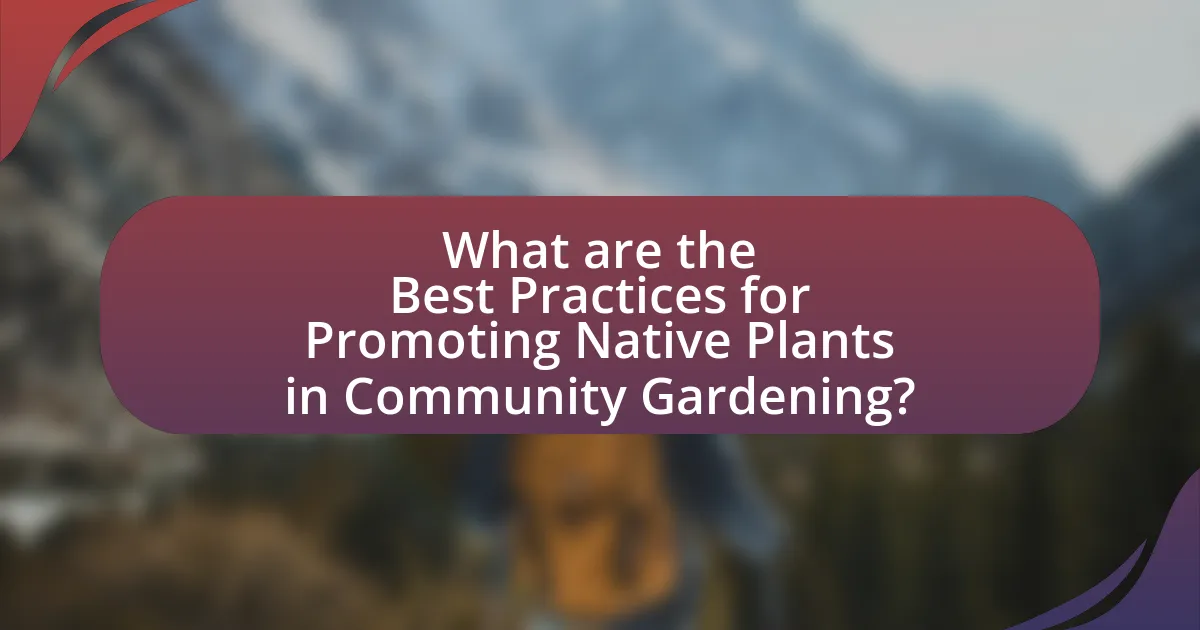
What are the Best Practices for Promoting Native Plants in Community Gardening?
The best practices for promoting native plants in community gardening include educating the community about the ecological benefits of native species, organizing workshops and planting events, and collaborating with local environmental organizations. Education fosters awareness of how native plants support local wildlife and biodiversity, which can increase community interest and participation. Workshops provide hands-on experience in planting and caring for native species, while collaboration with organizations can offer resources, expertise, and funding opportunities. These practices are supported by studies showing that community engagement in gardening activities enhances environmental stewardship and promotes sustainable practices.
How can communities effectively educate the public about native plants?
Communities can effectively educate the public about native plants through organized workshops, informational signage, and community events. Workshops provide hands-on learning experiences, allowing participants to engage directly with native plants and understand their ecological benefits. Informational signage in public gardens or parks can offer concise facts about native species, their roles in local ecosystems, and tips for cultivation. Community events, such as plant swaps or native plant sales, foster interaction and encourage local residents to explore and appreciate native flora. Research indicates that educational programs that involve community participation significantly enhance awareness and appreciation of native plants, leading to increased conservation efforts.
What strategies can be used to raise awareness about the benefits of native plants?
To raise awareness about the benefits of native plants, community engagement strategies such as workshops, educational programs, and social media campaigns can be effectively employed. Workshops can provide hands-on experiences, allowing participants to learn about native plants’ ecological benefits, such as supporting local wildlife and improving soil health. Educational programs in schools can instill knowledge about biodiversity and conservation from a young age. Social media campaigns can reach a broader audience, utilizing visuals and informative content to highlight the advantages of native plants, such as their low maintenance and drought resistance. Research indicates that communities with active engagement in native plant initiatives see increased biodiversity and improved ecosystem services, reinforcing the importance of these strategies.
How can social media and local events promote native plant gardening?
Social media and local events can effectively promote native plant gardening by raising awareness and fostering community engagement. Social media platforms allow for the sharing of educational content, success stories, and visual inspiration related to native plants, reaching a broad audience quickly. For instance, campaigns like #NativePlantMonth on platforms such as Instagram and Twitter encourage users to post about their experiences with native gardening, creating a sense of community and shared purpose.
Local events, such as plant swaps, workshops, and community gardening days, provide hands-on opportunities for individuals to learn about native plants, connect with local experts, and engage with fellow gardening enthusiasts. According to a study by the University of Florida, community gardening initiatives that incorporate educational workshops significantly increase participants’ knowledge and interest in native plant gardening. This combination of social media outreach and local events cultivates a supportive environment that encourages sustainable gardening practices centered around native species.
What partnerships can enhance the success of native plant initiatives?
Collaborations with local conservation organizations, educational institutions, and community groups can significantly enhance the success of native plant initiatives. Local conservation organizations provide expertise in native species and habitat restoration, which is crucial for effective implementation. Educational institutions can facilitate research and provide resources for community engagement, fostering awareness and understanding of native plants. Community groups, including gardening clubs and neighborhood associations, can mobilize volunteers and resources, ensuring broader participation and support for native plant projects. These partnerships create a network of knowledge, resources, and community involvement that is essential for the sustainability and impact of native plant initiatives.
How can local organizations collaborate to support community gardening efforts?
Local organizations can collaborate to support community gardening efforts by forming partnerships that leverage resources, expertise, and community engagement. For instance, local nonprofits can provide funding and educational workshops on sustainable gardening practices, while schools can integrate gardening into their curriculum, fostering youth involvement. Research indicates that community gardens can increase local biodiversity and improve food security, which aligns with the goals of organizations focused on environmental sustainability and community health. By sharing resources such as land, tools, and volunteers, these organizations can create a more robust support system for community gardening initiatives, ultimately enhancing the role of native plants in promoting sustainable practices.
What role do schools and educational institutions play in promoting native plants?
Schools and educational institutions play a crucial role in promoting native plants by integrating environmental education into their curricula and engaging students in hands-on gardening projects. These institutions often establish native plant gardens on their campuses, which serve as living laboratories for students to learn about local ecosystems, biodiversity, and the importance of native flora. Research indicates that educational programs focused on native plants can enhance students’ understanding of ecological principles and foster a sense of stewardship towards the environment. For example, a study published in the Journal of Environmental Education found that students participating in school-based gardening programs showed increased knowledge and positive attitudes towards native plants and conservation efforts.
What practical tips can help communities successfully implement native plant gardening?
Communities can successfully implement native plant gardening by starting with education and awareness programs that inform residents about the benefits of native plants, such as improved biodiversity and reduced water usage. Engaging local experts or organizations can provide valuable resources and guidance. Additionally, communities should create a plan that includes site selection, soil preparation, and plant selection tailored to local conditions. Establishing a maintenance schedule and involving volunteers can ensure ongoing care and sustainability. Research indicates that native plants require less maintenance and are more resilient to local pests and diseases, making them a practical choice for community gardens.
How can communities assess their gardening needs and goals?
Communities can assess their gardening needs and goals by conducting surveys and community meetings to gather input from residents about their preferences and requirements. This participatory approach ensures that the gardening initiatives align with the interests and needs of the community members. For example, a study by the American Community Gardening Association found that community gardens that actively involve local residents in planning are more successful and sustainable. Additionally, analyzing local environmental conditions, such as soil quality and climate, helps communities identify suitable plants, including native species that thrive in the local ecosystem, thereby enhancing the effectiveness of their gardening efforts.
What resources are available for ongoing support and education in native plant gardening?
Resources for ongoing support and education in native plant gardening include local extension services, native plant societies, online courses, and community workshops. Local extension services, such as those provided by universities, offer research-based information and guidance tailored to specific regions. Native plant societies, like the North American Native Plant Society, provide resources, networking opportunities, and educational materials focused on native species. Online platforms, such as the National Wildlife Federation’s website, offer courses and webinars on native gardening practices. Community workshops often organized by local gardening clubs or environmental organizations provide hands-on learning experiences and expert advice. These resources collectively enhance knowledge and skills in native plant gardening, promoting sustainable practices within communities.
